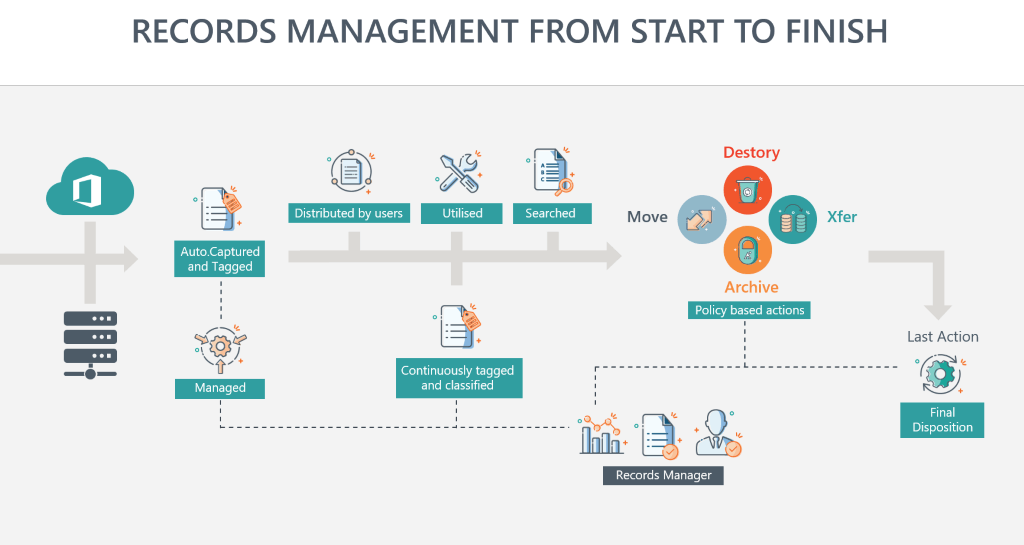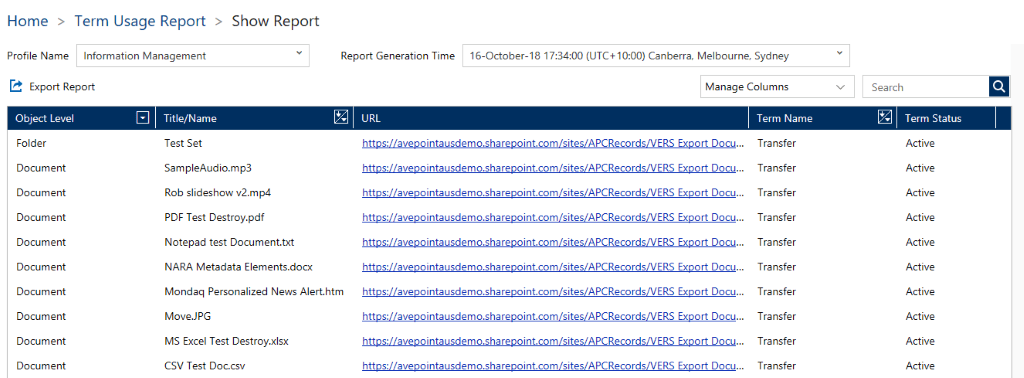Need top-tier tools for effective records management? Download our free NARA resource kit here!
This is the third post in our NARA series. Check out the other posts below!
- The Reports That Records Managers Can’t Live Without
- 7 Simple Steps Records Managers Can Take to Develop a Risk/Value Framework
- How to Start Optimizing Email Records Management ASAP
- Email Records Management Done Right: A Walkthrough of NARA’s Guidelines
- 3 Clear-Cut Ways to Get Executive Buy-In on Your Records Management Initiative
As I reflect on 2018—during which I traveled the world speaking to organizations about records management—I was continually shocked by how often organisations confided to me that they do not routinely destroy records in accordance with their retention schedule. As it turns out, we’re much more diligent about identifying and preserving records than we are about destroying them.
Records managers move information through a lifecycle determining what should be retained permanently (a very general rule shows this is about 5% of total content) and what can be destroyed when it is no longer required for business purposes. Records that we determine should be retained forever are always of high value to an organisation and, more often than not, have ongoing archival value since they’re typically of significant public interest.
So, it’s completely understandable that a large part of a records manager’s time is invested in identifying these important records and then closely managing them through their lifecycle.

What’s the Big Deal?
Why am I harping on this? Well, it’s important! Sitting on content that you could have or should have deleted can lead to serious consequences.
To begin with, it exponentially increases risk for the company. In fact, organisations can findthemselves in trouble more often for failing to destroy records rather than failing to keep them.
If you have seen the Netflix series Tidying Up with Marie Kondo (and if you haven’t, check it out–it’s fantastic!), you will have been introduced to a number of people who were completely overwhelmed by the enormous amounts of clutter in their home. They always had way too many of the same thing, things that they never used, and things they bought two (three, four, five!) times because the original got lost in all the clutter. Marie Kondo works with these overcluttered individuals to sort, categorise, and ultimately dispose of their stuff.
There is a good link to records management here. Think of end users being completely overwhelmed by the “clutter” of their system. They are searching for content that they know is there but be surfaced because the valuable information is hidden beneath a sea of content that could probably be deleted.
Maybe they are spending too much time searching for the right information, or maybe they are recreating things that already exist because they just can’t find the original. Either way, users end up being overwhelmed by information and the need to painfully sort through everything with no promise of finding what it is they were looking for.
As a records manager, we can make life that much easier for the users we serve by removing content that is no longer required once its business purpose has been reached. Of course, we do this under a disposition authority or disposal schedule, but we ensure that users can find the information they need to do their job quickly, easily, and efficiently by removing irrelevant or redundant records.

Why the Reluctance to Hit “Delete?”
There is typically a myriad of excuses when we dig into why organisations don’t dispose of their records. Here are some of the most common that I hear out in the field:
“Storage is cheap.”
I cannot count the number of conversations I’ve had with IT departments about the need to destroy records where ultimately the conversation ended with “but storage is cheap.”
That’s a statement that is hard to argue with because storage really is cheap. I remember saving for a memory card that had a whole 8MB of storage. Nowadays, not only would something that small not even be made, but I could buy something with significantly more storage for significantly less cost than what I paid for my 8MB. So, yes, we can agree that storage is definitely cheap. However, what more and more organisations are starting to realise is that what’s not cheap about storage is the ongoing cost of management and the risk related to holding onto things for longer than is required.
“I don’t trust the system or process.”
One of the first things I did when I started in a new role as an organisational records manager was to put a complete disposal hold across everything. I wasn’t confident at all that we were going to be able to run a process without destroying records before their due date. This was largely in part because I didn’t trust the classifications or file plan terms that had been rolled out to records by users.
This is not an unreasonable excuse for halting or delaying disposal, but it does require planning and action to ensure that these issues can be resolved. In this instance, it was important to put an internal team together to review the file plan and understand how it had been rolled out, making adjustments where we thought there were errors. Relying heavily on reporting and analysis, we could quickly identify glaring errors and make appropriate adjustments.
We could break the project down by starting with low-hanging fruit and looking for records we knew we could update in bulk. Once we were confident we had a handle on the tagging and things that did need to be resolved, we could use reporting again to see what could be disposed and be confident we were making a good decision. With that, we could then proceed to understand the disposition activities.

“I can’t get the content owners to sign off.”
I think this is the easiest one to come to terms with. Business owners can often feel quite protective of their information and be very reluctant to destroy it. Reasons might include “We might need it one day” or “I worked really hard on that, I don’t want to see that effort destroyed.” Other reasons might be as simple as not having the time to review or make a decision about what should be retained and what should be destroyed. They have a day job after all!
This is where it’s important to work with your users to help them understand the importance to reducing the “noise” of irrelevant information in the system and even potentially assist them with making some of those difficult destroy decisions. Remembering to find the benefit for the user (better search results, anyone?) is key to helping them through this process, especially when having their buy in for these decisions can be a vital part of a disposition process.
Best Practices Guide: Records Management for the Digital Era
“We’re being conservative.”
This one comes in different flavors. Sometimes these folks will call themselves pack rats or obsess over the potential of destroying something they’ll need in the future. By not destroying the items, they feel as though they’re taking a conservative posture. This is, in my humble opinion, the most tragic case.
Not disposing of content ends up being anything but conservative. They are subjecting themselves to increased risk by sitting on content. For instance, in litigation an organization will have to hand over any records related to the case even if they were eligible for disposition in the past).
The Pack Rat’s Call to Action
1. Have confidence in your solution and undertake remedial action if you don’t. AvePoint’s records management solutions use a term (or file plan) usage report to show exactly how content is being classified so you can proactively monitor your file plan scheme, ensure that it’s being used appropriately, and allow you to take action if it’s not.

2. Work with your users and find solutions that work for them. AvePoint Records includes a multi-stage manual approval process that allows business owners to review records in bulk for destruction, approval, rejection, or escalation.

3. Implement a defensible destruction process. This ensures that integrity is maintained throughout the disposal process. To support this, you can retain a metadata stub in place following disposal. You can also produce a disposal certificate at the end of the process that outlines all the records disposed of as part of a particular job. This can be saved back to the system as a record, ensuring that you can always prove that disposal occurred as part of an approved process.

Disposal is nothing to be scared of provided you have the right systems and processes in place to ensure integrity and defensibility. It’s also very refreshing to remove content that is no longer required for business purposes, making it easier to find information and, overall, reduce the risk of over-managing records that you simply don’t need to.

